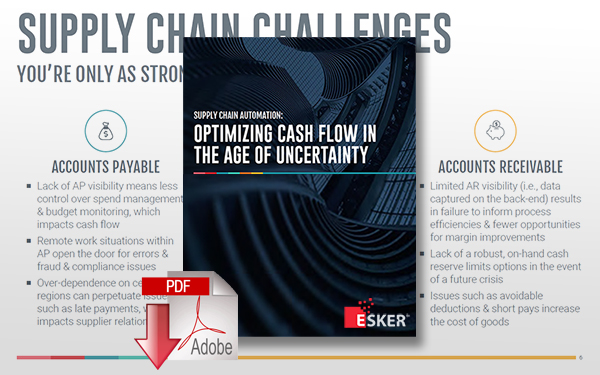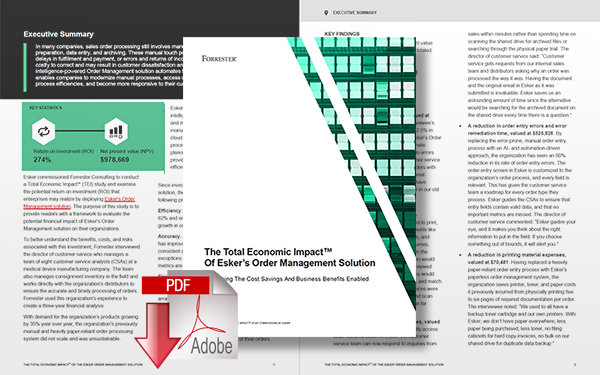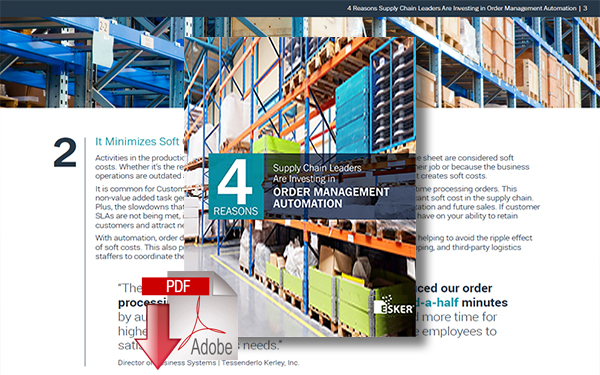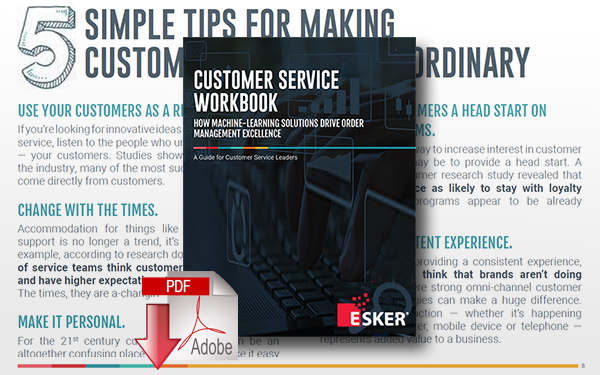4 Reasons Supply Chain Leaders Are Investing in Order Management Automation Solutions

Supply chain leaders work in a competitive environment, and in order to get ahead of the competition, they are increasingly turning to order processing automation solutions.
Order Management Automation
There is a noticeable shift occurring in the world of order management.
Traditionally, projects related to order-taking were spearheaded by the customer service department. Not anymore.
The pressures of today’s global economy have forced supply chain functions to play a more direct and strategic role in reducing costs, improving the customer experience, and driving added value throughout the organization.
Naturally, supply chain leaders now have a significantly higher rate of interest and involvement in order management initiatives.
Supply chain leaders work in a competitive environment, and in order to get ahead of the competition, they are increasingly turning to order processing automation solutions.
Below are the four key reasons order management automation is emerging in the supply chain:
1. It Reduces Hard Costs
Manual order management practices are inherently inefficient. The expenses associated with the equipment and consumables alone (e.g., fax machines, ink, paper, storage space, etc.) needed to manually process sales orders can create a hotbed of hard costs.
One of the biggest contributors to increased hard costs is order entry errors. According to A.T. Kearney, the average cost to rework an order is $200-250. (1) Depending on the industry though, the cost can be even higher. In the food and beverage industry, perishable items are being distributed, representing even more lost value if errors occur. In the life sciences, the industry lost orders, delivery delays or other errors can have dramatic effects on patient care - opening the door to potential regulatory ramifications.
How does an automated order management solution reduce these hard costs? First, since the workflow is completely electronic, it eliminates the reliance on costly paper-based consumables and equipment. Secondly, with human involvement taken out of order entry, errors are eliminated and the cost of reprocessing orders is avoided. Lastly, as your business grows, automation allows your team to handle increased order volumes without adding headcount (i.e., fewer FTE salaries to take on).
(1) 2003. RFID/EDC: Managing the Transition. A.T. Kearney
“MEDRAD, Inc. was able to repurpose 14 FTEs for higher-value activities and achieve $742k in cost savings one year after implementing Esker’s Order Processing automation solution.”
2. It Minimizes Soft Costs
Activities in the production process that are not easy to quantify and excluded from a balance sheet are considered soft costs. Whether it’s the result of employees lacking the necessary capabilities to perform their job or because the business operations are outdated and antiquated, the way a company conducts its business is what creates soft costs. It is common for Customer Service Representatives (CSRs) to spend at least 20% of their time processing orders. This non-value added task generates more costs than the value it creates - making it a significant soft cost in the supply chain. Plus, the slowdowns that these non-value tasks create can also affect your business reputation and future sales. If customer SLAs are not being met, it can be difficult to measure the precise financial impact this can have on your ability to retain customers and attract new ones.
With automation, order data is instantly captured and accurately fed into the supply chain, helping to avoid the ripple effect of soft costs. This also provides more time for customer service, production planners, shipping, and third-party logistics staffers to coordinate the delivery of goods and eliminate added costs.
Empowering CSRs with Tech: How Automation Brings You Closer to Customers
When you’re a customer service manager (CSR), you’re responsible for a lot: the loyalty and happiness of your customers, the success and satisfaction of the people on your team, and so much more - but not everyone makes it easy.
With the help of an AI-driven order automation solution that captures, routes, and archives orders as they arrive, CSRs can be freed up from error-prone data entry and time-intensive order retrieval tasks to do more of what they’re good at serving your customers.
In the episode of this Livestream Series, Esker Customer Advocate Becky Mender and Jeremy Deschaurs will explore how through order management automation, you can empower CSRs to:
- Quickly retrieve any and all orders (even before processing)
- Instantly view order images and run customizable reports on orders
- Communicate with customers via an online chat tool for a more personalized experience
Click on the video above and to the right to Listen Now!
“The results have been fantastic - we’ve actually reduced our order processing time from three minutes down to one-and-a-half minutes by automating with Esker. Not only have our CSRs had more time for higher-value tasks, but we’ve also been able to repurpose some employees to satisfy other business needs.” Director of Business Systems | Tessenderlo Kerley, Inc.
3. It Improves Visibility Across the Board
The Aberdeen Group recently found that organizations believe “improving internal cross-departmental visibility” and “streamlining processes for easier monitoring and enhanced visibility” to be the top two strategies for alleviating the pressures of today’s supply chain costs and complexities. (2) The increasing amount of activities, logistics, and channels involved in the supply chain make visibility a necessity. For supply chain owners, visibility is the key to mitigating risks, cutting costs, and meeting or exceeding customer SLAs.
Luckily, leading order processing solutions come equipped with intelligent and customizable dashboards that provide full visibility and enable users to facilitate daily tasks, monitor performances, and react quickly to prevent problems or spot opportunities early. Added oversight is delivered by customizable Key Performance Indicators (KPIs) that users can easily track and monitor (e.g., orders approved, processing time by CSR, priority orders to validate, customer issues per month, etc.). Providing immediate updates on when an order has been received, confirmed, and shipped, along with instant access to documents supporting the movement of goods, better equips all departments to deliver an optimized customer experience.
(2) Heaney, B. (May 2013). Supply Chain Visibility: A Critical Strategy to Optimize Cost and Service. Aberdeen Group
“Our distribution center’s managers can now see the number of orders in the queue and use that data to allocate resources and forecast what needs to be done with supply chain and staffing.” Director of Customer Experience, Parts Town
4. It Enhances the Customer Experience
The customer experience is the product of your customer’s end-to-end journey with you, and the supply chain plays a large role in it. Supply chains are established to move goods to customers quickly, efficiently, and accurately - business advantages that translate into customer benefits. If the delivery of a customer’s products is not handled correctly within the supply chain, that entire customer experience, along with company revenue, is in jeopardy.
In fact, Forrester recently found that organizations considered “customer experience leaders” grow revenue 3x faster than “customer experience laggards.” (3)
One of the most effective ways to improve customer experience is repurposing talented staff to more value-added tasks. Customer service teams that are free to focus on activities beyond data entry are able to deliver an exceptional customer experience every time - something automation is able to provide with ease.
(3) Manning, H. & Czarnecki, D. (June 21, 2016). Customer Experience Drives Revenue Growth. Forrester Research
Conclusion
Automated order management represents huge advantages for supply chain leaders that choose to embrace it. In today’s fast-paced, complex business climate, order processing automation eases the burdens of manual processes and creates an optimal environment for order processing - empowering your business to be more strategic and value-added in all its functions.
Related Resources
Supply Chain Automation: Optimizing Cash Flow in the Age of Uncertainty
This eBook examines the current challenges faced by supply chain leaders and the increasingly important role that automation is playing as businesses push for cash flow optimization. Download Now!
The Total Economic Impact™ of Esker’s Order Management Solution
Esker commissioned Forrester Consulting to conduct a Total Economic Impact™ study and examine the potential ROI that enterprises may achieve with Esker’s Order Management solution. Download Now!
4 Reasons Supply Chain Leaders Are Investing in Order Management Automation
This ebook details how supply chain leaders work in a competitive environment, and in order to get ahead of the competition, are increasingly turning to order processing automation solutions. Download Now!
How Machine-Learning Solutions Drive Order Management Excellence
Download this Customer Service Workbook to discover industry tips and best practices for bringing efficiency and profitability to order management while freeing up your Corporate Social Responsibilities. Download Now!
The AI Advantage
Businesses eager to create a competitive advantage are recognizing that the future is at the intersection of humans and machine intelligence, and that's where this guidebook helps. Download Now!
More Resources from Esker
Related Article: How Automation Makes Handling Customer Inquiries Easy to Achieve With a Digital Assistant



















